This 1960s style office block has been constructed to form the scenic break at the east
side of the Hornsey Broadway project, and measuring in at 28 inches will almost fill the width of the
baseboard. It is built using components from the obsolete Tri-ang 'Arkitex' range, with Plastruct sections,
and is shown here in its raw state awaiting detailing and weathering.
*****************************************************************************************************************************************************************
PETE JOHNSON 

A model visiting the workbench recently has been 40 129, based on the Lima product.
After some adjustments to the pony-wheel set-ups this loco (and stablemate 40 118) gave stirling service
during the recent Alexandra Palace appearance of Wibdenshaw. Re-inspired by this improved road-holding,
plans to add etched fan grills to these two models are now progressing, and work on a third example has resumed.

A close-up view of the new Class 40 - a centre headcode example this time. This is again
based on the Lima, although to bring out the best in this model quite a lot of work on the cab fronts,
glazing, and chassis are required. This view shows the modified windscreen framing, with beading added in
microstrip before enlargement of the openings to the correct size. The cabside windows have also been
extended downwards slightly, worksplates added in 5 thou plastic, and various mould tool lines carefully
removed. At the cab doors the moulded grab handles have been removed and will be replaced with 0,45mm
nickel silver wire. On the roof the boiler access panels and cantrail grills have been adjusted to the
correct pattern for this sub-type.

The bogies for the North British Class 16 are nearing completion, based on the Alexander
Models castings. The loco has a single Mashima motor driving through 60:1 gear sets. The spoked wheels are
by Alan Gibson, fitted on EM Gauge Society stepped axles. The power bogie has four concealed sprung-plunger
pickups, and the pick-up system for the trailing bogie has yet to be fitted.

Another steam-outline project for Ian, this time an LNER J72 0-6-0T based on his bargain
buy of an abandoned project from a show. The excellent Mainline shell is paired with a compensated chassis
built from the Perseverance kit. Romford wheels and a 60:1 gear set on a Mashima motor complete the dynamics.
The addition of handrails and pipe detail should see this become a tidy model, to be finished as 69016 in
an early 1960s condition.

Some further views of the J72 as the bodyshell detailing progresses. 69016 was one of the
type modified after delivery to have vacuum brake and steam heat connections. The extra pipes between the
boiler and cab have been added using brass wire. Smaller pipework has also been added for the steam drying
system on the front sandboxes. The as-supplied handrail knobs have mostly been replaced with more finescale items.

Cab detail has been added using an adapted Alexander Models cast whitemetal boiler
backplate intended for the G5 class. The open roof vent is made from a brass offcut.

On the back of the bunker the handrail has been renewed using finescale knobs and 0,45
brass wire. The lamp brackets have been added in brass strip, or using a brass offcut shaped to suit.

The chassis for the J72, showing the low-slung Mashima motor and flywheel. This
arrangement has the advantage of minimal intrusion into the cab, and allows the correct ‘daylight’
beneath the boiler forward of the sidetanks.

Also in the steam workshops the two further LNER J27 0-6-0s continue to make slow
progress. The tender for one of these is shown awaiting painting. This model has been adapted slightly
from the supplied kit parts to add an extra coal rail, as shown by photographs of the chosen locomotive in the mid-60s.

B459553 is the completed Palwag conversion of a Dia 1/019 Medfit, it is pictured
on Canada Road during the recent Cheltenham show. Light weathering and markings have been applied
to match the appearance shown in the photo which inspired this project. The limited space available
on the end stanchion required the numbers and letters to be applied one at a time…..but looking
closely at the real wagon shows an identical bunching-up of the stencilled characters! On this
particular example the running number was also repeated on one of the drop-in panels in a more crudely stencilled style.

DB905066 is a Lowmac EK to Dia 2/244. This has been built from an old Airfix kit –
moulded in bright yellow plastic! Although some of the Airfix detailing is a bit basic, the principle
dimensions and shapes look to be good. To give some improvement, a few extra rivet heads and webs
have been added as appropriate prior to painting. The model is finished as if recently transferred
into departmental stock, with a ‘D’ overpainted onto the running number, and will accompany the
Cowans Sheldon hand crane on track maintenance duties around Canada Road.

A recent visitor for minor attention is BR standard Cattle B893085. On this wagon
patch painting and the post-1964 application of boxed numbers and ‘XP’ markings are shown. The model
was built from the Airfix kit some years ago, with minor improvements to the side door hinge areas.

Two views of an ISO 20 foot ‘red stripe’ Freightliner container in original livery.
This is part of the 10-wagon train which is a regular on Wibdenshaw, but this particular wagon was
OMWB during a visit for attention. The containers on this train are modified Triang Hornby models,
with replacement end doors featuring locking bar detail made from plastic strip and rod. The box
number markings have been put together from Modelmaster alphabets on white strips cut from a
Fox shock-van sheet. This distinctive livery has been overlooked by the 4mm transfer suppliers,
which has frustrated attempts to model the early corrugated-sided steel boxes which Freightliner introduced.

Another view, showing the fixed end of the same box. Here the moulded raised band
under the stripe has needed removal, with corner lock and framing detail added. Freightliner
trains in this livery are a firm memory from my childhood, but are rarely seen modelled to finescale
standards. Little did I know in 1974 how this emerging form of freight movement would spell the
end for so many varied wagon types! These early lightweight aluminium boxes are now also a part of history,
although few (if any) have been preserved. A couple of 30 footers, carrying the remains of these
colours, linger at the back of Bridgnorth shed (SVR) as storage units, and it would be nice to think
one might be saved before aluminium rot destroys it completely.
The Freightliner train project utilises the Triang-Hornby model, first produced in the late 1960s,
and a good scale model for its time. Despite the wide choice of livery transfers now available from Fox, Modelmasters,
and elsewhere, the red stripe freightliner livery has never been available as far as I know. I did approach Cambridge
Custom transfers about doing some to order but he was far from keen. As a result all the 'Freightliner' and 'Freightliners
Limited' branding is the original Hornby artwork carefully preserved or re-touched after other work on the boxes. So
the red-stripe 30 foot boxes are cut-and-shut adaptations of 20 footers, with the cut pieces arranged to put the Hornby
markings on the right part of the stripe!
The box numbers were Modelmasters alphabet sheets in red and dark blue, applied one letter at a time onto white
panels cut from Fox shockvan stripes. The door arrows badges were from a Fox sheet - it may have been a 2mm scale sheet
to get the small size. The red triangles were cut from large panels of red transfer film, but I can't remember what the
red transfers were actually meant to be for, and the data blocks below the red stripe were cut together from overlapped
black loco datablocks from the Fox sheet which includes the grey 'railfreight' era of BR locos.
The lack of the 'Freightliner' title as a 4mm transfer has frustrated my plans to model the early corrugated steel
sided boxes which were pioneered during the red stripe era....I live in hope that one day somebody may make these markings
available, but suppose the demand wouldn't actually be that great. I even took detailed measurements of the markings off
the surviving red-stripe boxes at Bridgnorth (SVR) which I still have tucked away somewhere I think. Having seen more
photos since the project I now realise the box number was repeated a further two times on the roof (for the benefit of
the overhead crane drivers).
*****************************************************************************************************************************************************************
JUNE 2010 UPDATE
*****************************************************************************************************************************************************************
PAUL JAMES 

Here are some of the pieces cut from the Airfix mk2d coaches, and will be re-arranged and
modified to represent a 'ECML high speed' version of a BFK.

The interior of the coach is from a old Hornby BFK, and fits well with a bit of modification.
*****************************************************************************************************************************************************************
PETE JOHNSON 

A project that was completed during the past winter was the Brush
class 53 ‘Falcon’ based on the Heljan product. The following views show some of the detail
tweaks applied to the cab, roof, and fuel tank group on this model. After removal of all
glazing and handrails, the bodyshell had all mould tool lines removed. The relief band on
the lower bodyside was also scraped with the edge of a sharp blade to reduce the stand-out
until the appearance better matched photographs of the prototype.
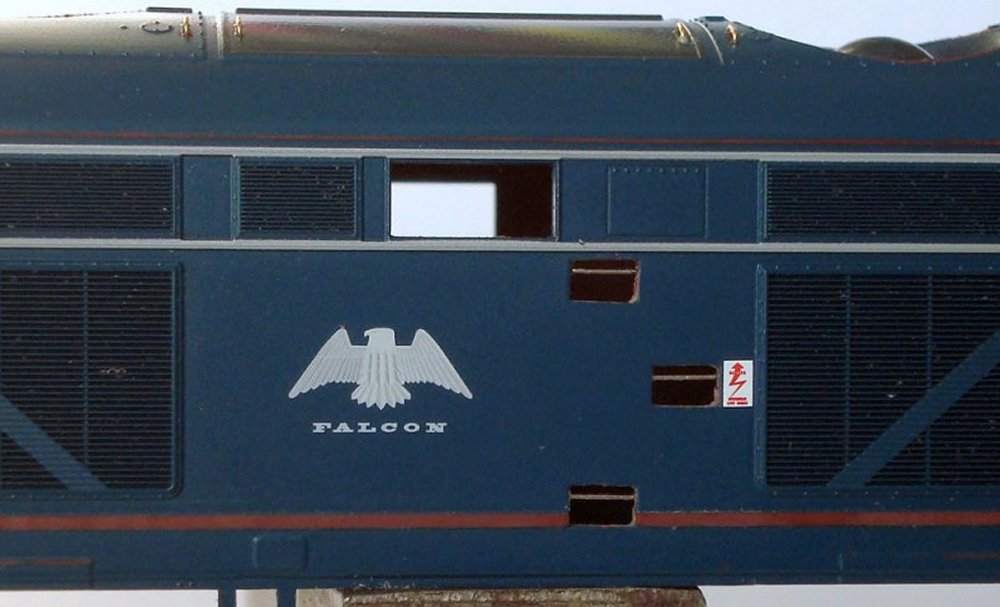
The bodyside ladder steps as supplied seemed rather shallow,
so to increase the depth they were drilled and filed through the shell. This gave the
opportunity to fit separate rungs made from 0,31mm nickel silver wire.

On the roof the fan grills have been fitted with finer etched mesh
available from Scalelink. Individual grab handles have also been added using 0,31mm wire.

The fuel tank group is not very accurate as supplied. To improve
the appearance the two tanks have been cut apart from the central battery boxes with a razor
saw and then deepened using a piece of 80 thou black plasticard bonded on top.

A view of the underside of the tank group after re-work. It can be
seen how the modified unit has a flat bottom surface for the full length. Some re-location
of the footstep holes and gauges was also required to better match the prototype.

Around the cab windows the framing was reduced in relief, and the
yellow paint removed from the sides of the openings. At the back corners of the recessed
window panels a careful filling and shaping job increased the radius of the corner blends.
5 thou plastic overlays were used to add the surrounds to the two footstep holes low down
on the cab ends.
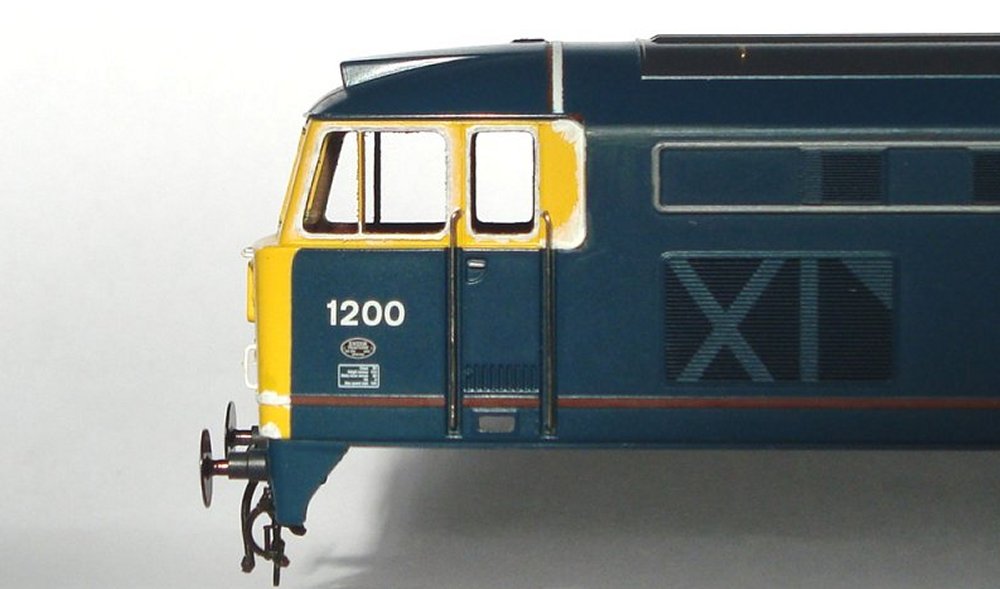
A profile view on the cabside showing the revised corner radii of
the recessed panel, the corrected handrails at the door, and the raised joint strip added
on the roof.

A view of the shell with the alterations underway. Matt white undercoat
has been applied thinly to the areas requiring yellow top coat.

A detail view of the cabside before weathering began. Joining the
bufferbeam valance to the main bodyshell removes the unsightly joint line and allows the
diagonal structural brace beneath the cabside to be added. Re-setting the glazing more
flush also improves the authenticity.
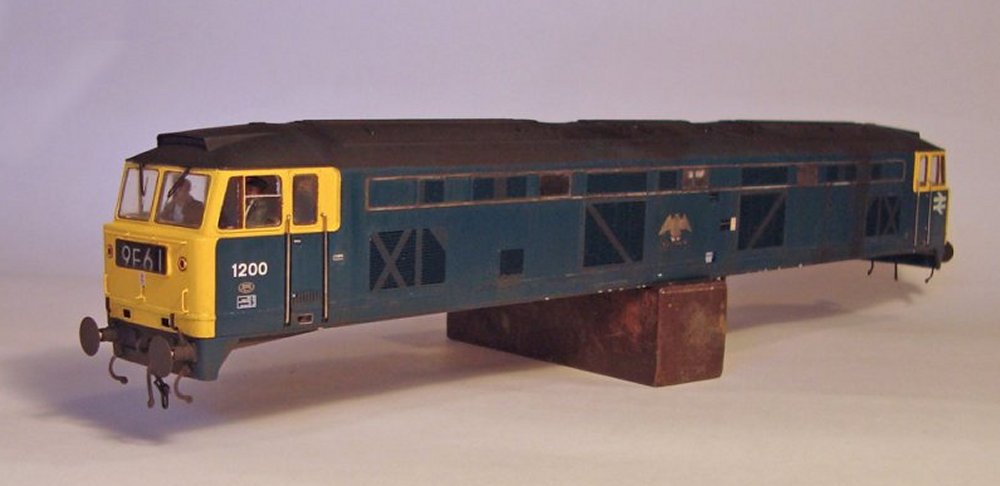
The completed bodyshell ready to be re-united with the chassis.
Weathering was matched to photographs of the loco from late 1974, during her time on trip
freight duties off Ebbw Junction shed. A feature article about this model appeared in
the recent ‘Rail Express’ magazine No. 168.

The LNER J72 0-6-0 shown previously on OMWB is pictured again with
all bodyshell detail items now added. The pipes below the footplate have been made using
plastic rod for good bonding to the shell, with brass rod employed for strength on the
more vulnerable end sections by the buffer beams.

Another view of the J72 this time with the chassis fitted. It is
currently awaiting final painting.

B201317 is one of the Coal 21 kit-conversions previously pictured
unpainted on OMWB. It is shown here in finished condition, weathered to a typical 1970s appearance.

B315077 was pictured previously OMWB after initial application of
rust spots, but still lacking underframe paint and final general grime. In this view the
completed finish is shown. The grime is applied as a tinted matt varnish, using a mix of
Humbrol matt 29 and 33, and then lightly dabbed off the flat panels with a clean piece
of kitchen paper to leave the most colour in the corners and angles where dirt would collect.

Another view of B315077 in finished condition. As this model portrays
a wagon re-bodied by BR in the early 70s the rusting is not as widespread as on older examples.

B201623 is another of the recently built Coal 21 wagons, pictured on an
earlier OMWB before weathering began. As this example is from the original build of the 1950s
the rusting and general condition are worse than B315077. Study of photographs show a mix of
rusty line scratches caused by shunting scrapes, and irregular shaped rust patches caused by
coal lump impacts within the wagon during loading. The weathering finish applied attempts to copy these two effects.
*****************************************************************************************************************************************************************
JULY 2010 UPDATE
*****************************************************************************************************************************************************************
PAUL JAMES 

In association with last months mark2D BFK conversion, a kitchen-buffet from the 15XX
number series is the next project, which requires some heavy modification from a Bachmann
restaurant-buffet as seen here. The first task was to fill in and blank off the existing detail on the
coach sides, before cutting out the required window positions and marking the door apertures.

Attention will then transfer to the roof and underframe, whilst the bodysides
await attention at the paintshops (along with other recent projects). This vehicle will
emerge in blue / grey livery and become part of the 'high speed' rake as used
out of Kings Cross in the 1970s.
*****************************************************************************************************************************************************************
PETE JOHNSON 

Class 25 D7629 has been pictured previously on the website, but has
recently received attention to the cab roof headcode box blends, and had improved marker
lights fitted. Separate cab door handrails and improved jumper-cables in nickel-silver
wire have also been added. The marker lights are each made of six small pieces of polystyrene
fitted into 3,0mm holes drilled in the cab end. D7629 carried this attractive livery through
into TOPS numbers (becoming 25 279), so would have looked this way around the period 1968-1974.

25 242 was my first Hornby/Bachmann hybrid, as featured in Rail Express
magazine when first completed. Since then it has proved a reliable performer, seeing use on
Canada Road, Wibdenshaw and Easington Lane at various times. Modelled to a photo of it rolling
through Manchester Victoria on a mixed freight, it always brings back good memories of those
carefree 70s summer days sat on the platform end GPO trolley…..

Although the recent Heljan OO release has reduced the rarity of Clayton
Class 17 locos on layouts, D8567 (based on the Techcad model) still draws comment when running
on Canada Road. After taking measurements off sole survivor D8568 at Chinnor several areas of
the resin shell were improved. These included the cab windows, exhaust stacks, headcodes, and
fuel tank group. D8567 was one of the first three Claytons to be repainted into blue, released
from Glasgow works in mid-1967, and the model carries the medium sized (2’ 0”) arrows badge
worn by the early blue examples.

Class 37 D6739 was pictured some time ago on OMWB with detailing of the
bodyshell in progress. It is shown here in completed condition, carrying a work-stained green
livery with small yellow panels, modelled to a photograph from 1968. The loco is based on the
Bachmann product, and has had some improvements made to the cab windows and headcode panels amongst other areas.
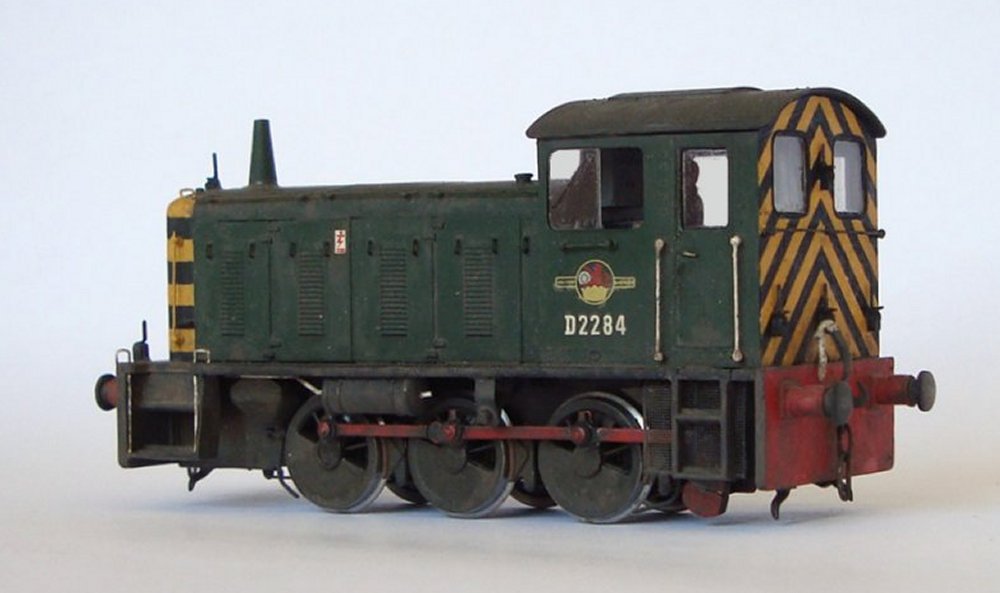
Class 04 D2284 is shown elsewhere on the website working on Canada Road.
To allow comparison with the recently completed Class 03 here are a couple of portrait shots.
The model has a Dapol kit bodyshell fitted on a Branchlines kit-built compensated chassis.
Gibson wheels are driven by a Portescap motor/gearbox, with Maygib sprung plunger pick-ups.
The combination of steel tyres with nickel-silver plungers seems to give particularly good pick-up,
and this model has been an excellent runner for the past few years.

The Class 04 had a similar general appearance to the 03, but can be
distinguished by the overhanging cab roof and lack of a stepped top to the bonnet compartment.
All were withdrawn by BR before receiving TOPS numbering, although many were sold to industry
for further use, and have thereby survived into preservation. D2284 was with the NCB in the
South Yorkshire coalfield for many years, and has now been superbly restored to ex-works
condition by the Heritage Shunter Trust at Rowsley.
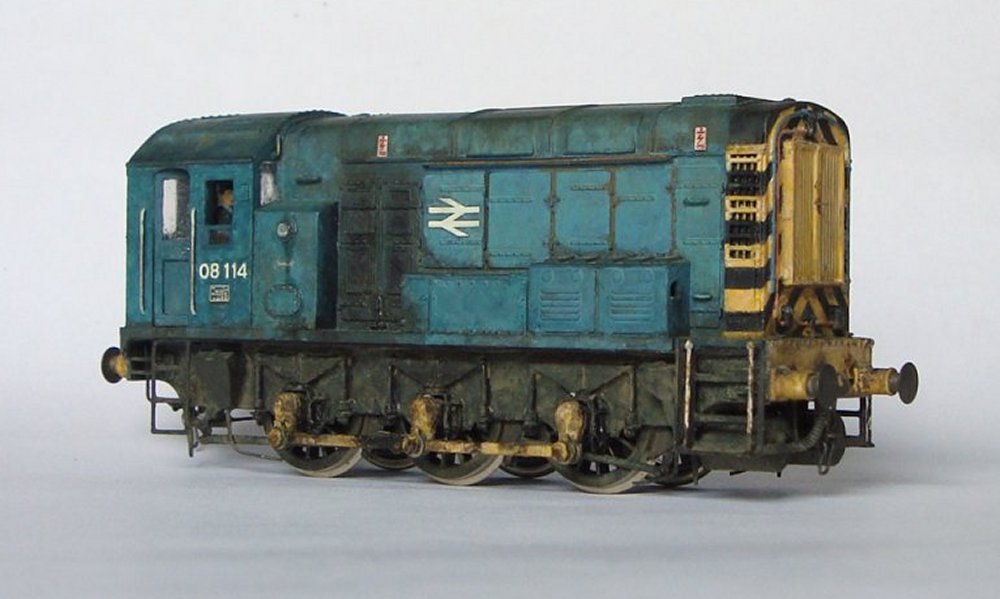
A regular sight on a 70s spotting safari was the well-faded Class 08……….
08 114 attempts to capture that look. The model is a combination of a modified Lima bodyshell
on a Crownline kit-built chassis. Attempts to apply the fading as a tint on top of standard
blue just didn’t look right, so the loco was actually finished in a mix of rail blue and matt pale
grey, before further weathering effects were applied on top.

Another view of 08 114 in faded blue. It is still possible to find 08s of
similar appearance today, despite the time that has passed since the end of the BR rail blue era.
Some of these survivors may have worn the same basic livery for over 40 years now!

ADM23, a Cowans Sheldon 10 ton hand crane, with converted Conflat runner wagon,
is pictured on Easington Lane during the recent Derby show. The crane is a heavily modified Triang
model, with rebuilt jib and balance weights. Slater’s plastic letters have been used for the cast
company name on the weights, although largely hidden by the wasp stripe pattern. At a recent show the
former operator of such a crane commented on the model, and explained their use on minor track renewal
work or loading. The term ‘hand crane’ meant that the crane was unpowered except by turning a handle
by hand, so a busy shift must have been a good work-out for the operators!

A BR Class 03 shunter rests in the cement sidings in this general view looking
across the Easington Lane station yard. (A fiddle-yard operator’s eye view of the layout taken
during the recent Derby show)

BR Class 04 D2284 is pictured out-stationed on the Easington Lane Blue Circle
depot shunt. (This photo again taken during the recent appearance at the Derby show).

B450032, a diagram 1/001 original pattern wood-sided BR Lowfit, was an unusual
visitor to the loading dock at Westfield Ltd of Easington Lane recently.

A classic piece of bold livery design from the late 60s/early 70s….. This OCL 20
foot ISO container (OCLU 263633-5) was recently spotted amid a pile of scrap at the Kingsbury yard.
A once common logo, it has been several years since I last saw an example, and that was in the reversed
white-on-blue version on a train in Switzerland! Three of the boxes on the freightliner rake that runs
on Wibdenshaw wear these colours.
*****************************************************************************************************************************************************************
KIER HARDY 

Things have been quiet on the Hornsey Road project recently, with so many other things
taking priority during the summer months. This view shows some of the scenic developments starting to take
shape around the area above the tunnels. The low level tunnels can be seen to the lower left of the picture,
whilst the bridge abutments and retaining walls are starting to take shape on the 'cut & cover' section
below the roadway. The loco shed area can be seen in the background, still in the early stages of planning and construction.

Some of the scenic modules are removable which helps to disguise the baseboard joins,
and allows detailing work to take place away from the layout.
*****************************************************************************************************************************************************************
AUGUST 2010 UPDATE
*****************************************************************************************************************************************************************
PETE JOHNSON 

During research for the recently completed pair of Dia 2/490 Trestle EA models I
discovered Paul Bartlett’s pictures of the similar Trestle AA to BR diagram 2/492.
This small batch of just 16 wagons were purpose-built by BR using the later style
clasp-brake Plate wagon underframe. Fitted with vacuum brakes, they lasted longer
in service than the unfitted Trestle EA conversions. A picture of one loaded with
sheet steel in Gloucester Docks in 1977 was reason enough to inspire a model.

Another view of the Trestle AA, now with brakegear added. The levers and V-hangers
have been adapted from 51L etched parts. The rivets have been applied one-by-one in
Geoff Kent style….time consuming - but does enhance the accuracy.

The chain anchor rings have now been added, and the model is now ready for painting. The
AA had uniform height sides and ends all round, unlike the EA, and these also had 3 extra
chaining points along the bodysides. Below the solebar the standard BR heavyweight w-iron
style was used, rather than the RCH pattern found on the EA.

The Trestle AA is pictured again with assembly completed. The chain ring fittings were
on the inside along the back of the wooden trestle, but on the outside of the low bodyside
panel along the front of the wagon to avoid damage during loading.

One of the early scratchbuilt wagons on Canada Road was a Dia 1/400 Single Bolster. This
was based on an Airfix mineral wagon underframe since the caption of the only photo I
had at that time suggested a 9’ 0” wheelbase. Reference to Rowland and elsewhere has now
shown 9’ 0” to be in error, as the unusually short 8’ 0” spacing of the LNER forerunner
was copied by BR. The model has recently been rebuilt to correct the length and wheelbase,
although the bodysides, bolster and w-irons have been salvaged from the original.

Another view of the rebuilt Single Bolster ready for final painting. The deck of these
wagons had rubbing plates to spread the weight of the swivelling central bolster.

Whilst researching the 1/400 bolster on Paul Bartlett’s website a later version of the
type, to Dia 1/402, seemed like a good variation on a theme. Although still without
vacuum brake, the wheelbase was increased to 10’ 0”, but the short overall length of the
LNER original was retained. Mostly replaced in traffic during the sixties by Twin or
Bogie Bolsters, many of these singles found later departmental use as crane runners
and general utility wagons.

Another view of the Dia
1/402 wagon. The bodysides and bolster are scratchbuilt using plasticard, while the
underframe is cut down from a Parkside chassis kit.

The 1/402 Single Bolster again, now with basic paint applied ready for lettering.
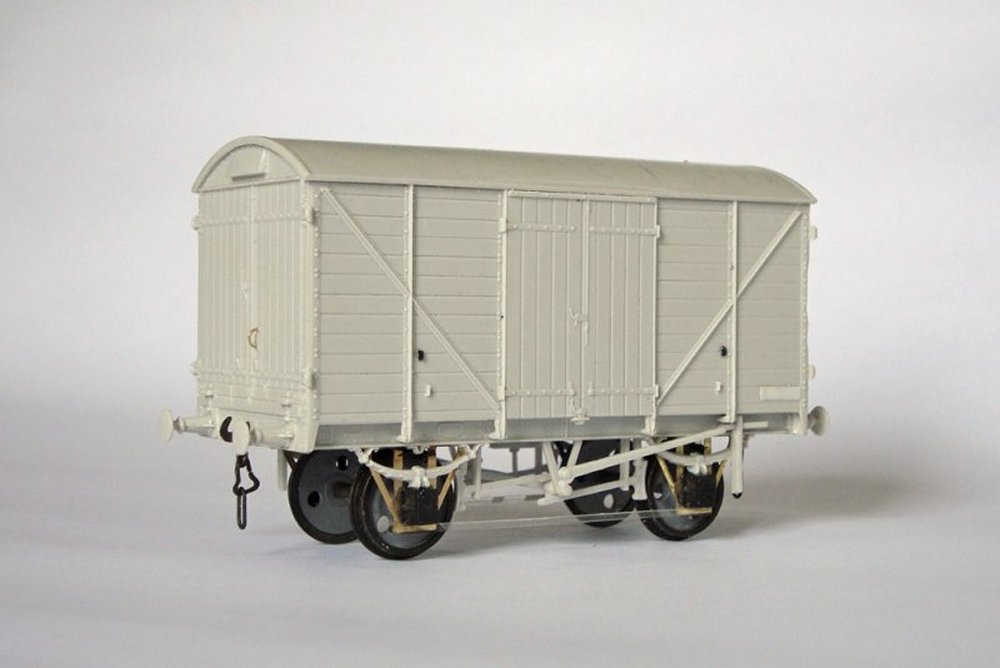
A recent project has been this GWR ‘Mogo’ van from the Ratio kit. It is being
modelled to a photo taken in 1964 when in regular service on BR.

B951979 is a BR standard 20 ton Brake Van built from the Airfix kit.
Although many of the BR brake van fleet had no vacuum brake most were finished in the bauxite
livery of fitted stock. Some later had grey end panels added to the bauxite scheme, but it was
relatively unusual to find all-grey examples by the mid-1970s. This model was based
on one seen in Barry scrapyard in 1980.
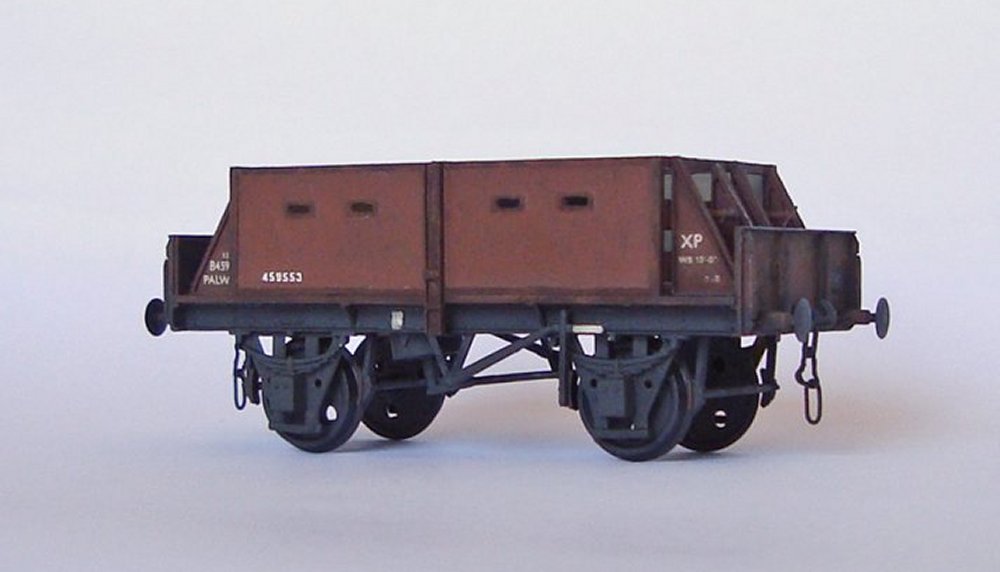
B459553 is the recently completed ‘Palwag’ wagon, pictured here in a studio setting.

D2511 is one of the original scratch-built shunter fleet on Canada Road. It is a
model of the small batch of re-styled Hudswell Clarke machines delivered to the London
Midland Region of BR. Often mistaken for the similar looking Class 07 during shows,
the smart centre-cab design was a huge improvement on the early Hudswell Clarke diesels
which had a chimney and cab lifted straight off the 0-6-0ST ‘Austerity’ tank.

Another view of D2511, the bodyshell is mostly plasticard with a brass roof, brass
was also used for the frames, with Romford wheels and a Portescap RG4 motor. The
type was associated with Barrow Docks for several years, although photographs more
commonly show examples at Derby or Willesden. Just one example survives (at the K&WVR)
being preserved after industrial service with the NCB.

BTH Class 15 D8229 has been featured previously on the website when under construction.
Despite being completed in time for Canada Road’s appearance at the NEC in 2007 the
finished model has not been pictured before. The loco is modelled to a photo of it in
1968 kindly provided by a Class 15 Preservation Society member – check out their
website for the latest news on progress restoring the only surviving example to working condition.

Another view of the completed D8229. Built using the Alexander Models whitemetal kit,
the model has proved to be a popular shunting/trip loco for the layout. The recent
Heljan release has lessened the rarity value, and they have even provided this exact
livery/number combination in ready-to-run form…..

Class 14 D9502 is based on the Konstruction brass kit, and modelled to an in-service
photo of it in the Forest of Dean. It is yet another type recently swept up by Heljan as
the final rush to offer all BR mainline diesels as OO gauge r-t-r models reaches an
end game. D9502 passed to the NCB North Eastern division after early retirement by BR,
and has been unusual for never having a repaint since first leaving Swindon when new.
It is now in the care of the Heritage Shunter Trust, who have the hard decision of
whether to restore it to pristine condition, or preserve the historic original paint finish.
*****************************************************************************************************************************************************************
GREG BROOKES 

Here's a Motorail flat number B745027 built to dia 1/189 (1968/1969), built from
redundant mark 1 coach underframes. Those in use with long distance holiday and passenger traffic were
in blue livery, whilst bauxite was generally used for 'factory fresh' bulk car deliveries.

Mainly built from scratch with a few added proprietry items. Guard rail made from plastruct and
styrene rod, the B1 bogies and underframe by Bachmann, and additional Coopercraft plastic parts.
*****************************************************************************************************************************************************************
KIER HARDY 

Hornsey Road is a section of the Hornsey Broadway layout project, which features
the locomotive depot and nearby surroundings, designed as a stand-alone exhibit or part
of the bigger Broadway picture. This view shows
part of the hidden trackwork under the depot area. Once the ground level is built up, access to some parts of
the trackwork will be limited, so the construction needs to be robust and fully tested. The track at the
baseboard join is reinforced with copper-clad sleepering, checkrails, and epoxy resin. Pattern makers dowels
are used on all baseboard joints.

Peaks and Class 40s are good test locos, having 16 wheels each..... and plenty of
propelling moves with long and short vehicles mixed together.
*****************************************************************************************************************************************************************
PAUL JAMES 

Another couple of pictures showing progress so far on the kitchen-buffet by Paul James.
























































































